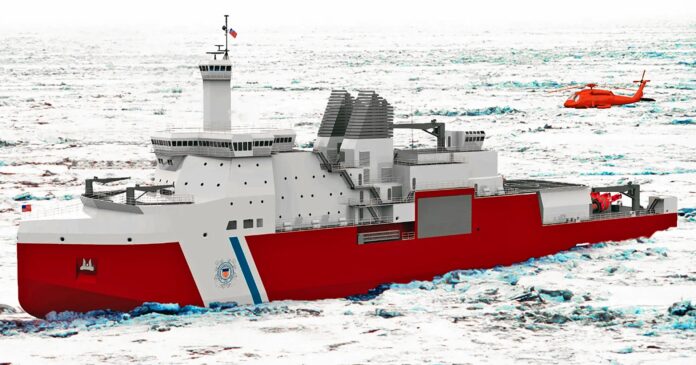The One Big Beautiful Bill Act, signed by President Donald Trump on July 4, includes a historic investment in US Arctic security, totaling nearly $9 billion for icebreakers that may put America back in charge of the frozen frontier.
The legislation delivers $4.3 billion for heavy Polar security cutters, $3.5 billion for medium Arctic security cutters, and an additional $816 million for lighter ice-capable vessels. It’s the largest Arctic maritime investment in US history, and it comes at a moment of escalating geopolitical stakes in the Far North.
Congressman Nick Begich is on the Coast Guard and Maritime Transportation subcommittee in the House.
“Arctic security is a crucial component of America’s national defense and border security portfolio, but we have deferred that investment for too long. This historic investment strengthens our response capacity, supports ongoing search and rescue missions, and enhances our ability to interdict foreign operators engaged in Illegal, Unreported, and Unregulated (IUU) commercial fishing,” Begich said.
‘Upon learning about chronic Coast Guard budget shortfalls as a member of the Coast Guard subcommittee and after meeting with senior Coast Guard leadership in Kodiak, Washington DC, and Tokyo, it was clear: We needed to make a significant Coast Guard investment and quickly. The OBBBA will make that happen,” Begich said.
Why it matters: Russia and China are joining forces in the Arctic
Over the past years when Joe Biden was president, Russia and China intensified joint naval patrols in the Arctic, while Moscow has been building new military bases across the Russian Arctic.
Meanwhile, China has pushed to rewrite the rules of Arctic governance, despite being thousands of miles from the polar region. Although China is not a full member of the Arctic Council, it was admitted as a permanent observer in 2013, which enabled Beijing to pursue push-in strategies, allowing it to speak and propose measures to the voting members. In essence, it gives China the ability to co-opt the voting members.
In 2018, China published a white paper outlining its goal to launch a polar Silk Road. It marketed itself as a “near Arctic state.”
The stakes are immense: the Arctic is estimated to hold 90 billion barrels of oil, 1,669 trillion cubic feet of natural gas, and 44 billion barrels of natural gas liquids.
Yet during the Biden administration, Arctic infrastructure stagnated. The US fleet of operational heavy icebreakers has remained at just one aging vessel, while Russia has more than 40.
President Trump’s Arctic response is a full-spectrum push to retake the initiative and includes:
- 40 new U.S. icebreakers funded by the One Big Beautiful Bill
- A pact with Canada and Finland to build 70–90 additional vessels
- A surge in US shipbuilding, reviving dormant shipyards to support Arctic dominance
This massive build-up is intended not just to catch up, but to leap ahead, because whoever controls the Arctic sea lanes and energy routes controls the future, with Alaska’s Arctic now a battleground for world dominance.
Leftists criticize the icebreaker funding as “wasteful.” But for conservatives and national security hawks, this is about sovereignty and survival in a changing geopolitical climate.
With Arctic temperatures warming and sea ice thinning, new maritime routes are opening that could rival the Suez and Panama Canals in global shipping importance.

Hopefully we produce the steel here to build these vessels. I would think the days of the US repurchasing the recycled crap steel from chinas supply of Barry’s “ cash for clunkers “ has been exhausted.
But, but, but, I thought this bill was only to strip money and food and healthcare from poor illegals and give it to billionaires. Nice work, Nick.
Congressman Begich is doing wonderful things for our beloved state and nation. Bravo! 💥🇺🇸
I hate to say it, but Lisa may deserve some credit here. She has been asking for more “Breakers” for years.
Of course it would never happen under the 12 year Obama- Biden communist regime.
Go Nick!
“………40 new U.S. icebreakers funded by the One Big Beautiful Bill
A pact with Canada and Finland to build 70–90 additional vessels
A surge in US shipbuilding, reviving dormant shipyards to support Arctic dominance………”
H U G E !!!
Geopolitically speaking, we need to find some way for us to live peacefully with each other.
You can’t live peacefully with people who want to kill us (Muslims) or conquer us (Communists). Peace for us can only be achieved through strength.
Yeah, I hope so.
Alaska is getting better and better as Drill Baby Drill ripples its way into the Deep State! Ship the oil and gas (LNG)off the North Slope always made perfect sense!
Great that the US Army Corps of Engineers withdrew their contract with ‘native’ entities for the Nome Port expansion project.
Issued by autopenJoe regime for $270M and 0 actual work conducted in FY22-FY23. Contract recipients had to temerity to demand an additional $650M to continue to do no work.
Pete Hegseth should be announcing a new competition – which the ‘natives’ expect another no-bid, no-compete, no-show, no-work griftgrant USAID style deal.
Think again
Is this true? Citation please.
It’s about time
We need refineries throughout Alaska.
[…] destroyers, drones and missile defense systems. However, a surprising portion is earmarked for Arctic icebreakers and undersea surveillance areas where China and Russia have intensified their […]